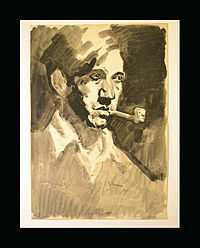David Gommon
| David Gommon | |
|---|---|
 Self portrait, Circa 1932 | |
| Born |
12 December 1913 Battersea, London |
| Died |
20 January 1987 (aged 73) Northhampton |
| Nationality | English |
| Field | painter |
David Gommon (12 December 1913 - 20 January 1987) was a British painter born in Battersea, South London.
Early life and education
David Gommon was born on 12 December 1913 in Battersea in South London. His father was a Londoner, a journeyman carpenter. His mother was from Fife, Scotland. David grew up in Battersea. He had one older sister. At 16 he was enrolled in Battersea Polytechnic and the Clapham School of Art. He was able to visit art galleries of the Netherlands to study the paintings of the great masters. He met art collector, Lucy Carrington Wertheim and, when he was 18-19 she became his patron paying £2 a week for “practically all the work I did, and I did a great deal”.[1]
Career
It was through Lucy Wertheim that he held his first one-man show at her gallery in Burlington Gardens, and attracted positive critical attention.[citation needed] During this time he met many other patrons of the arts and he painted the young dancers Margot Fonteyn and Robert Helpmann at Saddlers Wells. He was part of the 20s group that included Christopher Wood, Barbara Hepworth, Roger Hilton, Robert Medley and Victor Pasmore.[citation needed] He was an intrepid cyclist, he never learned to drive, and cycled to Scotland in his teens to visit his mother’s homeland.
In his own work he gradually focussed on the essence of the English and Welsh landscapes. In 1938 he stopped painting altogether.
Personal life
During the Second World War his spinal curvature rendered him unfit for military service, he served in the London Auxiliary fire service. During the war he had met and married Jean Vipond.
Teaching
After the War he was offered his first teaching job at Northampton Grammar School[2] where he worked and taught many pupils including actor/artist Jonathan Adams [3] of whom he completed a portrait.[4] While here he painted prolifically until he retired. His approach was varied; working in oil, gouache, pencil and ink. Materials were expensive; he frequently used whatever he could find to paint on, some supports less durable than others. His art room was always a scene of intense creative activity, its walls bursting with papier-mache figures, African masks, abstract paintings, and portraits of his pupils. He would often paint striking reproductions of famous paintings to illustrate his lessons; the sets for the schools regular theatrical productions would be designed, painted and constructed in the art room.
In the 1960s he delivered WEA Lectures on Art for a number of years, in Northampton and the county. He believed strongly that art should be open and accessible to everyone. His last commission, the two large murals at St. Crispin's hospital, Northampton, arose from this conviction.
Reviews
Art critic Ian Mayes summed up this aspect of his work most succinctly in his review of his 1975 exhibition at St Catharine's College, Cambridge.
- “I know of few artists whose work communicates such a sense of joy in life as that which comes from these beautifully quiet, very modest and English paintings, so accurate in their evocation of the changing moods and feeling of nature. The landscapes (which together with the related paintings of enclosed gardens and cricket matches I consider to be his finest work) show that in his use of colour and simplified shapes he has found a personal and eloquent language, perfectly suited to its purpose; and an important part of that purpose is the expression of wonderment and delight in nature.“
He retired early to give himself time to paint freely. He died suddenly in 1987, leaving a legacy of over 450 works.
Exhibitions
His work forms part of the permanent collections at;
- Salford City Art Gallery;
- Whitworth Art Gallery;
- Northampton Art Gallery;[4]
- The University of Leicester;
- Auckland Art Gallery, New Zealand;[5]
- Queensland Art Gallery, Brisbane, Australia;[6]
- Barbados City Art Gallery;
- The Chapel of Canberra Grammar School, Australia.
He held exhibitions and has been shown at:-
- Northampton Art Gallery;
- The House of Commons;
- The Herbert Gallery, Coventry;
- Kettering Art Gallery;
- Luton Museum and Art Gallery;
- Michael Jones Jewellers, Northampton;
- Burton-on -Trent Art Gallery;
- Gainsborough’s House, Sudbury;
- Stafford Art Gallery;
- South London Art Gallery-Camberwell;
- The Paris Salon 1979;
- The Liverpool School of Architecture;
- The University Centre, Northampton;
- Vaughan College, Leicester;
- St Catherine’s College, Cambridge;
- The Fairfield Halls, Croydon;
- Durham City Art Gallery;
- The Angel Row Gallery, Nottingham;
- St Crispin Hospital Northampton-Creation Mural and Shopping Mural;
- St Saviours Parish Church, Oxton - Arts festival;
- The Williamson Art Gallery, Birkenhead.
Bibliography
- Wertheim, Lucy (1947)Adventure In Art, Nicholson and Watson, London, P48. ISBN 1871360021
- Hoskin, Sarah and Haggard, Liz (1999) Healing the Hospital Environment, Taylor Francis, P62-63. ISBN 3639328698
References
- ↑ http://www.davidgommon.com/biography
- ↑ Ian Mayes. "Henry Bird | News | The Guardian". The Guardian (London: GMG). ISSN 0261-3077. OCLC 60623878. Retrieved 25 January 2013.
- ↑ "biography". jonathanadamsartwork.com. 2008. Retrieved 25 January 2013.
- ↑ 4.0 4.1 Jonathan Adams by David Gommon, BBC Your Paintings.
- ↑ http://www.aucklandartgallery.com/the-collection/browse-artists/1635/david-gommon/images
- ↑ http://collection.qagoma.qld.gov.au/qag/imu.php?request=display&port=45000&id=17c6&flag=start&offset=0&count=20&view=list&PublishOnIMuInternet=Y&value1=gommon%20&column1=creatorculture